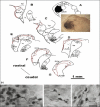Surgical approaches to tinnitus treatment: A review and novel approaches
- PMID: 22140639
- PMCID: PMC3228384
- DOI: 10.4103/2152-7806.86834
Surgical approaches to tinnitus treatment: A review and novel approaches
Abstract
Background: Tinnitus, a profoundly widespread auditory disorder, is characterized by the perception of sound in the absence of external stimulation. The aim of this work is to review the various surgical treatment options for tinnitus, targeting the various disruption sites along the auditory pathway, as well as to indicate novel neuromodulatory techniques as a mode of tinnitus control.
Methods: A comprehensive analysis was conducted on published clinical and basic neuroscience research examining the pathophysiology and treatment options of tinnitus.
Results: Stereotactic radiosurgery methods and microvascular decompressions are indicated for tinnitus caused by underlying pathologies such as vestibular schwannomas or neurovascular conflicts of the vestibulocochlear nerve at the level of the brainstem. However, subsequent hearing loss and secondary tinnitus may occur. In patients with subjective tinnitus and concomitant sensorineural hearing loss, cochlear implantation is indicated. Surgical ablation of the cochlea, vestibulocochlear nerve, or dorsal cochlear nucleus, though previously suggested in earlier literature as viable treatment options for tinnitus, has been shown to be ineffective and contraindicated. Recently, emerging research has shown the neuromodulatory capacity of the somatosensory system at the level of the trigeminal nerve on the auditory pathway through its inputs at various nuclei in the central auditory pathway.
Conclusion: Tinnitus remains to be a difficult disorder to treat despite the many surgical interventions aimed at eliminating the aberrant neuronal activity in the auditory system. A promising novel neuromodulatory approach using the trigeminal system to control such a bothersome and difficult-to-treat disorder deserves further investigation and controlled clinical trials.
Keywords: Cochlear implant; Tinnitus; microvascular decompression; neuromodulation; stereotactic radiosurgery/stereotactic radiotherapy; trigeminal nerve; trigeminal nerve stimulation.
Figures


Similar articles
-
Functional anatomy of the human cochlear nerve and its role in microvascular decompressions for tinnitus.Neurosurgery. 2004 Feb;54(2):381-8; discussion 388-90. doi: 10.1227/01.neu.0000103420.53487.79. Neurosurgery. 2004. PMID: 14744285
-
Microvascular decompression of cochlear nerve for tinnitus incapacity: pre-surgical data, surgical analyses and long-term follow-up of 15 patients.Eur Arch Otorhinolaryngol. 2008 Apr;265(4):397-401. doi: 10.1007/s00405-007-0471-1. Epub 2007 Oct 2. Eur Arch Otorhinolaryngol. 2008. PMID: 17909826
-
Multi-sensory integration in brainstem and auditory cortex.Brain Res. 2012 Nov 16;1485:95-107. doi: 10.1016/j.brainres.2012.08.037. Epub 2012 Aug 24. Brain Res. 2012. PMID: 22995545 Free PMC article.
-
Surgical brain modulation for tinnitus: the past, present and future.J Neurosurg Sci. 2012 Dec;56(4):323-40. J Neurosurg Sci. 2012. PMID: 23111293 Review.
-
Revisiting the cochlear and central mechanisms of tinnitus and therapeutic approaches.Audiol Neurootol. 2015;20 Suppl 1:53-9. doi: 10.1159/000380749. Epub 2015 May 19. Audiol Neurootol. 2015. PMID: 25997584 Review.
Cited by
-
Quality of life and audiologic performance through the ability to phone of cochlear implant users.Eur Arch Otorhinolaryngol. 2015 Dec;272(12):3685-92. doi: 10.1007/s00405-014-3448-x. Epub 2014 Dec 20. Eur Arch Otorhinolaryngol. 2015. PMID: 25527411
-
Anatomo-Physiologic Basis for Auricular Stimulation.Med Acupunct. 2018 Jun 1;30(3):141-150. doi: 10.1089/acu.2017.1254. Med Acupunct. 2018. PMID: 29937968 Free PMC article. Review.
-
Tinnitus: Is there a place for brain stimulation?Surg Neurol Int. 2016 Feb 10;7(Suppl 4):S125-9. doi: 10.4103/2152-7806.176134. eCollection 2016. Surg Neurol Int. 2016. PMID: 26958429 Free PMC article.
-
Altered Topological Patterns of Gray Matter Networks in Tinnitus: A Graph-Theoretical-Based Study.Front Neurosci. 2020 May 27;14:541. doi: 10.3389/fnins.2020.00541. eCollection 2020. Front Neurosci. 2020. PMID: 32536854 Free PMC article.
-
Influence of the brain function through the peripheral nerves.Surg Neurol Int. 2012;3(Suppl 4):S245-6. doi: 10.4103/2152-7806.103012. Epub 2012 Oct 31. Surg Neurol Int. 2012. PMID: 23230528 Free PMC article. No abstract available.
References
-
- Adams PF, Hendershot GE, Marano MA. Current estimates from the National Health Interview Survey, 1996. Vital Health Stat. 1999;10:1–203. - PubMed
-
- Ahmad N, Seidman M. Tinnitus in the older adult: Epidemiology,pathophysiology and treatment options. Drugs Aging. 2004;21:297–305. - PubMed
-
- Akdogan O, Ozcan I, Ozbek C, Dere H. Tinnitus after cochlear implantation. Auris Nasus Larynx. 2009;36:210–2. - PubMed
-
- Amoodi HA, Mick PT, Shipp DB, Friesen LM, Nedzelski JM, Chen JM, et al. The effects of unilateral cochlear implantation on the tinnitus handicap inventory and the influence on quality of life. Laryngoscope. 2011;121:1536–40. - PubMed
-
- Baguley DM, Atlas MD. Cochlear implants and tinnitus. Prog Brain Res. 2007;166:347–55. - PubMed
LinkOut - more resources
Full Text Sources

